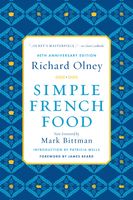Advertisement
Chicken
Poulet
Published 1974
When dealing with chickens, a sauté is not a stew, for a true stew, it is claimed, never contacts a liquid during the cooking process (why only chicken should be distinguished with correct denominations is a mystery). There are hundreds of formulas for chicken sautés (they may be applied, as well, to rabbit, milk lamb, or baby goat), but they are all the same: The cut-up chicken is colored in butter, olive oil, or a combination of the two, covered, and cooked gently for another 15 or 20 minutes (a garnish, usually precooked, is added at some point during the last 15 minutes), and a rapid sauce is prepared by deglazing, usually with white wine, occasionally with red wine, sherry, or another fortified wine or, very rarely, with a blazing brandy (in Normandy the pan is deglazed with flaming applejack and the reduction finished with cream); the sauce is finished, often only by swirling butter into the deglazing reduction, sometimes with cream, tomato, prepared sauces, etc., boiled down to the desired consistency, butter whisked in away from the heat. Normally, the chicken pieces are dressed on a platter with their garnish and the sauce is poured over at the moment of serving. The most practical method of operating in a home kitchen—and one that eliminates the loss of precious heat—consists of coloring the chicken in a large skillet or plat à sauter, transferring the pieces to an oven casserole to finish cooking (the garnish being added at this time or a few minutes later), deglazing the original cooking receptacle, draining off the juices from the casserole into the deglazing liquid, and pouring the finished sauce back over the chicken and its garnish, which will then be served directly from the casserole.


